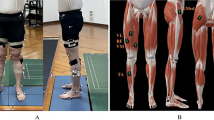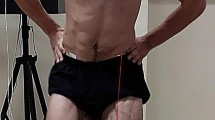Abstract
Background
There is lack of sufficient research evidence when we examine how knee osteoarthritis (OA) affects performance of stand to sit, a very important task for daily function.
Aim
The aim of this study was to investigate if women with unilateral knee OA perform the stand to sit task in the same way as healthy adults of the same age.
Methods
Fifteen women with knee OA (age 64.05 ± 4.23 years, height 161.52 ± 5.03 cm, and mass 75.23 ± 8.51 kg) and fifteen healthy subjects of the same age (age 62.13 ± 4.15 years, height 160.73 ± 5.10 cm, and mass 75.20 ± 9.87 kg) volunteered to participate. The experimental task required sitting to a chair starting from a bipedal standing position. Electromyographic activity of the vastus lateralis and biceps femoris was examined for both legs. In addition, joint kinematics of the lower limb and vertical ground reaction forces were recorded bilaterally.
Results
Movement duration was not different between the groups. Women with knee OA showed significantly lower vastus lateralis activation and higher knee muscle co-contraction of the affected leg compared to the same leg of the control group. In addition, they had smaller knee range of motion for both legs compared to the control group participants.
Conclusion
Knee muscle co-contraction is employed by women with knee OA to perform the stand to sit movement at the same duration as their healthy counterparts. This compensatory mechanism may be important for the task execution, but at the same time, it can be harmful for the joint.







Similar content being viewed by others
References
Marsh AP, Rejeski WJ, Lang W et al (2003) Baseline balance and functional decline in older adults with knee pain: the Observational Arthritis Study in Seniors. J Am Geriatr Soc 51:331–339
Hubley-Kozey CL, Hill NA, Rutherford DJ et al (2009) Co-activation differences in lower limb muscles between asymptomatic controls and those with varying degrees of knee osteoarthritis during walking. Clin Biomech (Bristol, Avon) 24:407–414. https://doi.org/10.1016/j.clinbiomech.2009.02.005
Slemenda C, Brandt KD, Heilman DK et al (1997) Quadriceps weakness and osteoarthritis of the knee. Ann Intern Med 127:97–104
Bennell KL, Wrigley TV, Hunt MA et al (2013) Update on the role of muscle in the genesis and management of knee osteoarthritis. Rheum Dis Clin N Am 39:145–176. https://doi.org/10.1016/j.rdc.2012.11.003
Hortobagyi T, Westerkamp L, Beam S et al (2005) Altered hamstring-quadriceps muscle balance in patients with knee osteoarthritis. Clin Biomech (Bristol, Avon) 20:97–104. https://doi.org/10.1016/j.clinbiomech.2004.08.004
Metcalfe AJ, Andersson ML, Goodfellow R et al (2012) Is knee osteoarthritis a symmetrical disease? Analysis of a 12 year prospective cohort study. BMC Musculoskelet Disord 13:153. https://doi.org/10.1186/1471-2474-13-153
Lewek MD, Rudolph KS, Snyder-Mackler L (2004) Quadriceps femoris muscle weakness and activation failure in patients with symptomatic knee osteoarthritis. J Orthop Res 22:110–115. https://doi.org/10.1016/S0736-0266(03)00154-2
Mundermann A, Dyrby CO, Andriacchi TP (2005) Secondary gait changes in patients with medial compartment knee osteoarthritis: increased load at the ankle, knee, and hip during walking. Arthritis Rheum 52:2835–2844. https://doi.org/10.1002/art.21262
Al-Zahrani KS, Bakheit AM (2002) A study of the gait characteristics of patients with chronic osteoarthritis of the knee. Disabil Rehabil 24:275–280
Bouchouras G, Patsika G, Hatzitaki V et al (2015) Kinematics and knee muscle activation during sit-to-stand movement in women with knee osteoarthritis. Clin Biomech (Bristol, Avon) 30:599–607. https://doi.org/10.1016/j.clinbiomech.2015.03.025
Hodges PW, van den Hoorn W, Wrigley TV et al (2016) Increased duration of co-contraction of medial knee muscles is associated with greater progression of knee osteoarthritis. Man Ther 21:151–158. https://doi.org/10.1016/j.math.2015.07.004
Schipplein OD, Andriacchi TP (1991) Interaction between active and passive knee stabilizers during level walking. J Orthop Res 9:113–119. https://doi.org/10.1002/jor.1100090114
Yoshida K, Iwakura H, Inoue F (1983) Motion analysis in the movements of standing up from and sitting down on a chair. A comparison of normal and hemiparetic subjects and the differences of sex and age among the normals. Scand J Rehabil Med 15:133–140
Ashford S, De Souza L (2000) A comparison of the timing of muscle activity during sitting down compared to standing up. Physiother Res Int 5:111–128
Kellgren JH, Lawrence JS (1957) Radiological assessment of osteo-arthrosis. Ann Rheum Dis 16:494–502
Bellamy N, Buchanan WW, Goldsmith CH et al (1988) Validation study of WOMAC: a health status instrument for measuring clinically important patient relevant outcomes to antirheumatic drug therapy in patients with osteoarthritis of the hip or knee. J Rheumatol 15:1833–1840
Hermens HJ, Freriks B, Disselhorst-Klug C et al (2000) Development of recommendations for SEMG sensors and sensor placement procedures. J Electromyogr Kinesiol 10:361–374
Davis ROS, Tyburski D, Gage J (1991) A gait analysis data collection and reduction technique. Hum Mov Sci 10:575–587
Radhakrishnan SM, Hatzitaki V, Vogiannou A et al (2010) The role of visual cues in the acquisition and transfer of a voluntary postural sway task. Gait Posture 32:650–655. https://doi.org/10.1016/j.gaitpost.2010.09.010
Kuhlow H, Fransen J, Ewert T et al (2010) Factors explaining limitations in activities and restrictions in participation in rheumatoid arthritis. Eur J Phys Rehabil Med 46:169–177
van Dijk GM, Veenhof C, Lankhorst GJ et al (2009) Limitations in activities in patients with osteoarthritis of the hip or knee: the relationship with body functions, comorbidity and cognitive functioning. Disabil Rehabil 31:1685–1691. https://doi.org/10.1080/09638280902736809
Hatzitaki V, Konstadakos S (2007) Visuo-postural adaptation during the acquisition of a visually guided weight-shifting task: age-related differences in global and local dynamics. Exp Brain Res 182:525–535. https://doi.org/10.1007/s00221-007-1007-z
Hong SL, Newell KM (2006) Practice effects on local and global dynamics of the ski-simulator task. Exp Brain Res 169:350–360. https://doi.org/10.1007/s00221-005-0145-4
Edelman GM, Gally JA (2001) Degeneracy and complexity in biological systems. Proc Natl Acad Sci USA 98:13763–13768. https://doi.org/10.1073/pnas.231499798
Bieleman HJ, van Ittersum MW, Groothoff JW et al (2010) Functional capacity of people with early osteoarthritis: a comparison between subjects from the cohort hip and cohort knee (CHECK) and healthy ageing workers. Int Arch Occup Environ Health 83:913–921. https://doi.org/10.1007/s00420-010-0541-3
Rutherford DJ, Hubley-Kozey CL, Stanish WD et al (2011) Neuromuscular alterations exist with knee osteoarthritis presence and severity despite walking velocity similarities. Clin Biomech (Bristol, Avon) 26:377–383. https://doi.org/10.1016/j.clinbiomech.2010.11.018
Schipplein OD, Andriacchi TP (1991) Interaction between active and passive knee stabilizers during levelwalking. J Orthopaed Res 9:113–119. https://doi.org/10.1002/jor.1100090114
Winby CR, Gerus P, Kirk TB et al (2013) Correlation between EMG-based co-activation measures and medial and lateral compartment loads of the knee during gait. Clin Biomech (Bristol, Avon) 28:1014–1019. https://doi.org/10.1016/j.clinbiomech.2013.09.006
Ramsey DK, Briem K, Axe MJ et al (2007) A mechanical theory for the effectiveness of bracing for medial compartment osteoarthritis of the knee. J Bone Joint Surg Am 89:2398–2407. https://doi.org/10.2106/JBJS.F.01136
Turcot K, Armand S, Fritschy D et al (2012) Sit-to-stand alterations in advanced knee osteoarthritis. Gait Posture 36:68–72. https://doi.org/10.1016/j.gaitpost.2012.01.005
Naili JE, Brostrom EW, Gutierrez-Farewik EM et al (2018) The centre of mass trajectory is a sensitive and responsive measure of functional compensations in individuals with knee osteoarthritis performing the five times sit-to-stand test. Gait Posture 62:140–145. https://doi.org/10.1016/j.gaitpost.2018.03.016
Winter DA (1984) Kinematic and kinetic patterns in human gait: variability and compensating effects. Hum Mov Sci 3:51–76. https://doi.org/10.1016/0167-9457(84)90005-8
Author information
Authors and Affiliations
Corresponding author
Ethics declarations
Conflict of interest
On behalf of all authors, the corresponding author states that there is no conflict of interest.
Ethical standards
All procedures performed in studies involving human participants were in accordance with the ethical standards of the Aristotles University of Thessaloniki research committee and with the 1964 Helsinki declaration and its later amendments or comparable ethical standards.
Statement of human and animal rights
This article does not contain any studies with animals performed by any of the authors.
Informed consent
Informed consent was obtained from all individual participants included in the study.
Additional information
Publisher's Note
Springer Nature remains neutral with regard to jurisdictional claims in published maps and institutional affiliations.
Rights and permissions
About this article
Cite this article
Bouchouras, G., Sofianidis, G., Patsika, G. et al. Women with knee osteoarthritis increase knee muscle co-contraction to perform stand to sit. Aging Clin Exp Res 32, 655–662 (2020). https://doi.org/10.1007/s40520-019-01245-z
Received:
Accepted:
Published:
Issue Date:
DOI: https://doi.org/10.1007/s40520-019-01245-z




